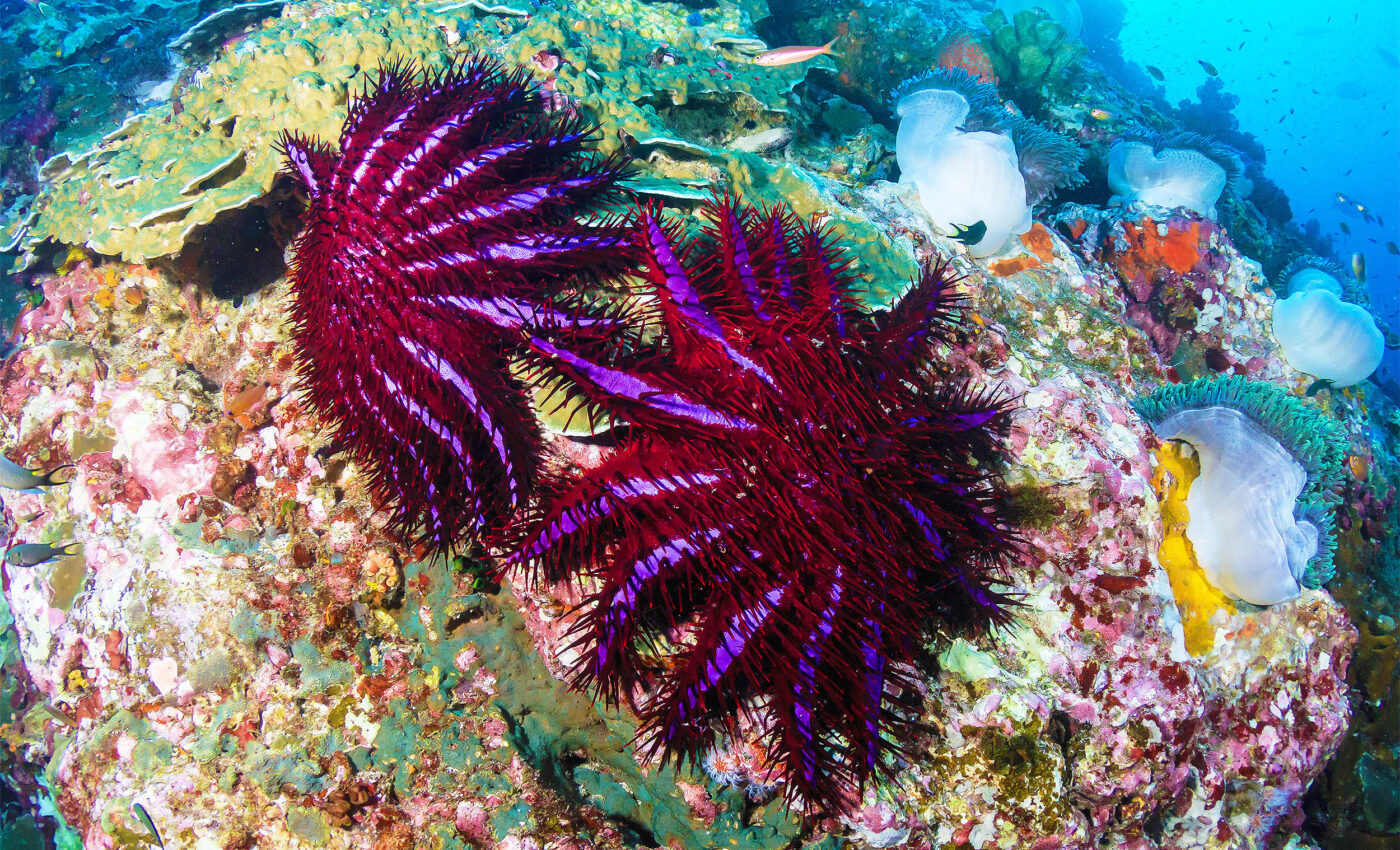
Killing crown-of-thorns starfish could save the Great Barrier Reef
In a world where coral reefs are under constant threat from various stressors, scientists are searching for effective ways to protect and preserve these vital ecosystems. A recent study has shed light on a promising approach: targeted surveillance and culling of crown-of-thorns starfish (CoTS).
The research, conducted by scientists from the Great Barrier Reef Marine Park Authority reveals that timely and sufficient control efforts during CoTS outbreaks can lead to a significant reduction in starfish numbers and a substantial increase in coral cover across impacted regions.
What are crown-of-thorns starfish?
The crown-of-thorns starfish (Acanthaster cf. solaris) is a large, predatory starfish that inhabits coral reefs in the Indo-Pacific region. It gets its name from the venomous spines that cover its upper surface, resembling a crown. These starfish can grow up to 40 cm in diameter and have up to 21 arms.
Feeding habits
Crown-of-thorns starfish feed on coral polyps, using their extrudable stomachs to digest the coral tissue. A single starfish can consume up to 6 square meters of coral per year.
In normal populations, these starfish play a role in maintaining coral diversity by preying on faster-growing coral species. However, when their populations reach outbreak levels, they can cause significant damage to coral reefs.
Threat posed by crown-of-thorns starfish
Crown-of-thorns starfish (Acanthaster cf. solaris) are native to coral reefs, as mentioned previously, but their outbreaks pose a major threat to coral health and resilience.
These outbreaks, along with other stressors such as coral bleaching, cyclones, and anthropogenic disturbances, contribute to the decline and degradation of coral reefs worldwide.
A single crown-of-thorns starfish, measuring a meter in diameter, can consume up to 10 square meters of coral annually.
Factors contributing to outbreaks
Several factors can contribute to crown-of-thorns starfish outbreaks:
- Nutrient enrichment: Runoff from agricultural and urban areas can increase nutrient levels in the ocean, promoting the growth of phytoplankton, which serves as food for crown-of-thorns starfish larvae.
- Overfishing: The removal of natural predators, such as triton snails and humphead wrasse, can allow crown-of-thorns starfish populations to grow unchecked.
- Larval survival: Environmental conditions that favor the survival and settlement of crown-of-thorns starfish larvae can lead to increased recruitment and population growth.
Power of targeted culling
To address this issue, the research team focused their efforts on the Great Barrier Reef, engaging in a culling program from 2012 to 2022.
They targeted 500 out of the park’s 3,000 reefs, identifying individual crown-of-thorns starfish and injecting them with vinegar or ox bile, which not only killed the starfish but also prevented them from releasing larvae.
The results of this targeted culling were remarkable. In the areas where culling was conducted, the researchers observed a 44% increase in coral reef coverage. In contrast, nearby parts of the reef where no culling had occurred continued to experience unabated coral loss.
Furthermore, the team discovered that culling starfish in specifically targeted areas dramatically reduced the spread of larvae, effectively preventing outbreaks in other reefs.
Pest management approach to crown-of-thorns starfish
The researchers describe their effort as similar to pest management. As human activities have allowed starfish populations to explode, the need has arisen to cull them to protect the health and resilience of coral reefs.
“Anthropogenically-driven disturbances are superimposing additional stressors upon the natural cycles of decline and recovery inherent to coral reef ecosystems,” the researchers wrote in their paper. “Major drivers of coral mortality on Indo-Pacific coral reefs are cyclones, coral bleaching events, and outbreaks of crown-of-thorns starfish.”
Implications for coral reef conservation
The test program conducted by the Great Barrier Reef Marine Park Authority has demonstrated that culling crown-of-thorns starfish can be an effective tool in helping to save not only the Great Barrier Reef but also other reefs around the world.
The study found that “timely and sufficient control efforts during CoTS outbreaks resulted in a sixfold reduction in starfish numbers and a 44% increase in coral cover across impacted regions.”
Desperate times, desperate measures
In summary, the targeted surveillance and culling of crown-of-thorns starfish have proven to be a powerful tool in the fight to save coral reefs from destruction.
By proactively identifying and eliminating these coral-consuming predators, scientists have demonstrated that they can significantly reduce starfish numbers, prevent the spread of larvae, and promote the recovery of coral reefs.
As we continue to face the challenges posed by climate change and human activities, this research offers a glimmer of hope for the future of these vital ecosystems.
It is now up to us to support and expand these efforts, working together to protect and preserve the beauty and biodiversity of our world’s coral reefs for generations to come.
The full study was published in the journal PLoS One.
—–
Like what you read? Subscribe to our newsletter for engaging articles, exclusive content, and the latest updates.
Check us out on EarthSnap, a free app brought to you by Eric Ralls and Earth.com.
—–













